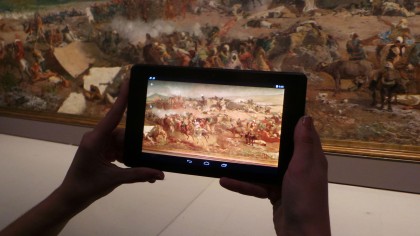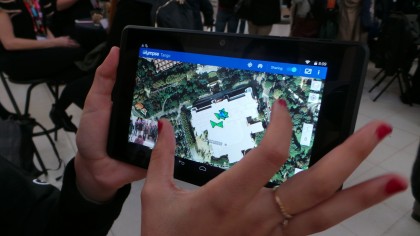Google just made the tablet the ultimate museum piece
This is what Project Tango was made for

Quite often we find ourselves staring down at our phone while exploring museums, frantically Googling topics to try and learn more about what I'm looking at.
Little plaques to the side of an exhibit never give enough information to truly explain what we're seeing and we wish there was something to help educate us further. Thankfully, Project Tango is here to help.
Google's indoor mapping tool has been around as a concept for quite some time now, but in partnership with Lenovo the company has finally installed it in its first public location.
We were lucky enough to be shown Project Tango working its magic at the Museu Nacional d'Art de Catalunya in Barcelona – and we can safely say, this is going to change the way you visit museums. At first you may think using a tablet will only distract from the education of museums, but in fact Tango can enhance it.

We were rather skeptical when walking into the first exhibit. That feeling continued when we had to calibrate the tablet by waving it round the room.
That involves spinning in circles for a few moments to let cameras and sensors on the back of the Dev Kit slate work out exactly where you're stood. From there it will then place you on the map and instruct you where to go first.
Project Tango doesn't use GPS; all the indoor navigation features are run through the camera technology on the back of the device, and that's why the Dev Kit tablet is so thick right now.
Sign up for breaking news, reviews, opinion, top tech deals, and more.
Locating the tablet only took a few moments, then Project Tango showed us where all the exhibits sat. This means you can separate the wheat from the chaff easier and just walk right up to that piece of artwork you'd like to see. There's no more having to search around for that one educational hit.

What we'd like to see next is a review system where visitors can provide a rating or comment on exhibits, and recommend the top picks for those short on time who just want to see the highlights.
Right now, Project Tango can navigate you where you want to go. For example, we chose a painting about a two minute walk through the museum, tapped on it and it set us on the trail.
Walking through windy corridors and complicated exhibits, the tech knew exactly where we were at all times and made sure we didn't bump into any walls or priceless art.

There are two modes for navigation right now. One with a simple floor plan, easiest for finding the exhibits you want to see, and another through the camera which generates an AR trail on the floor for you to follow.
If you walk the wrong way through the museum it'll automatically calibrate the next best route and send you on your way.
When we were nearing the chosen exhibit, a little pop up tells you where to stand to get the best view. Then there was a notification to say we had arrived, and we were told to point the tablet at the exhibit itself.
Our first port of call was the epic Battle of Tétouan by Marià Fortuny. This painting takes up an entire wall in Barcelona's largest museum. It's huge, and depicts a part of the Spanish-Moroccan war of the 1800s.

This is where Project Tango will change how we learn in museums. Points of interest in the artwork itself are highlighted by the program.
If you press on these you'll then get a little explanation sharing information about what you've seen, allowing you to learn more about the artwork itself.
It means rather than reading a small plaque, there are dynamic pictures and more information to help you fully appreciate the piece.

One of the highlights is how easy this system is to implement for the museums. All it requires is someone to walk through the museum one way and go back through exactly the same route but the opposite way to create the map. If Project Tango is using a 180-degree lens, that's all you need to grab the footage.
From there it's just a case of data entry to show what and where the exhibits are as well as adding in more information about the art.

A Google spokesperson said the intention is for museums to initially hand tablets out to guests when they walk in the door, much like places do with audio guides already.
However, as the technology required for Tango works its way into standard smartphones and tablets, museums can begin to phase those tablets out and allow visitors to use their own devices in the years to come.
It's sure to better engage children, while teaching them more effectively about what they're seeing.
There's a lot of room for growth too. Keeping children engaged can sometimes be a struggle in these sort of attractions - so why not implement games within Project Tango?
Imagine a treasure hunt through the museum, which also teaches children at the same time - all through Project Tango.

Google representatives spoke about how having this tech on your phone camera will allow you to walk into a store and track down an item without having to ask for directions from staff. Google may see Project Tango as a wider technology with the focus on retail elements, but this is where it will be most useful.
There's no reason to think that museums wouldn't want to drop audio headsets in favor of Project Tango. Especially when tablets are available on the cheap and Tango will be so easy to set up.
In a time when you can explore The British Museum through Google Maps, it's clear that museums want to adopt new technology and become part of the twenty first century. This is the way they can do it.

James is the Editor-in-Chief at Android Police. Previously, he was Senior Phones Editor for TechRadar, and he has covered smartphones and the mobile space for the best part of a decade bringing you news on all the big announcements from top manufacturers making mobile phones and other portable gadgets. James is often testing out and reviewing the latest and greatest mobile phones, smartwatches, tablets, virtual reality headsets, fitness trackers and more. He once fell over.